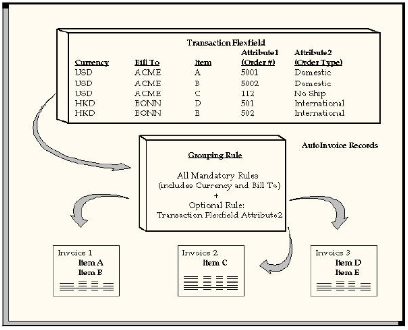Example of an AutoInvoice Grouping Rule
This example illustrates how to use grouping rules to group transaction lines into transactions during AutoInvoice import.
Scenario
Define an AutoInvoice grouping rule that specifies that to appear on the same invoice, items must match on all mandatory attributes, such as currency (CURRENCY_CODE) and customer bill-to address (ORIG_SYSTEM_BILL_ADDRESS_ID), and must also match on the optional attribute of sales order type (SALES_ORDER_SOURCE).
Transaction Details
During AutoInvoice import, assume that all mandatory attributes match other than currency and customer bill-to address.

Items A and B share the same currency and sales order type, so they appear on the same invoice (Invoice 1). Item C has the same currency as A and B, but it has a different sales order type, so it appears on its own invoice (Invoice 2). Items D and E share the same currency and sales order type, so they appear on the same invoice (Invoice 3).
Result
Because of the optional attribute of sales order type, AutoInvoice created three invoices. If the grouping rule had designated only mandatory attributes, then AutoInvoice would have created only two invoices.